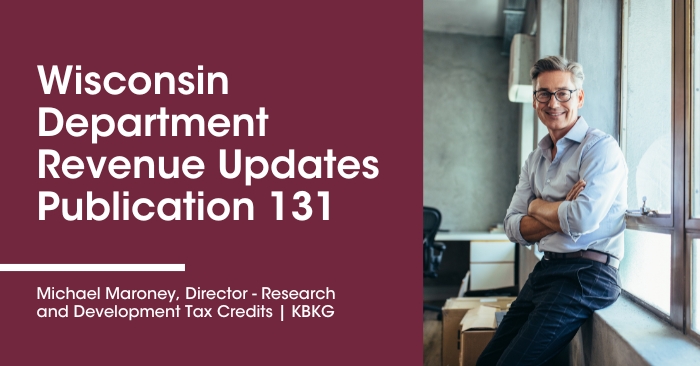Wisconsin Department Revenue Updates Publication 131 - R&D Tax Credits
Thought Leadership by Michael Maroney, Director – Research and Development Tax Credit Services | KBKG
Understanding tax incentives and research credits can often be as intricate as deciphering a complex puzzle. Fortunately, the Wisconsin Department of Revenue has developed the newly updated Publication 131, a comprehensive guide that unravels the nuances of Tax Incentives for Conducting Qualified Research in Wisconsin.
If you’re currently engaged in research activities and find your business pondering over the potential tax implications, this recent update should provide clarity for R&D tax credit considerations.
What Is the R&D Tax Credit?
The Research and Development Tax Credit is a federal tax liability reduction companies can take for approved domestic expenses. The rate of reduction is dollar for dollar and could equate to approximately 10 cents for every dollar spent on qualified research. Qualifying research and development expenses include the development, improvement, or design of a product, process, invention, formula, technique, or software.
This credit can lead to significant savings that free up cash for new product development, paying down debt, securing new financing, hiring additional employees or for new capital projects. For companies that meet the criteria of a Qualified Small Business, the R&D credit can be used to offset quarterly payroll taxes. For tax years beginning January 1, 2023, the maximum R&D tax credit for payroll tax doubled from $250,000 in 2022 to $500,000. Many states have also enacted R&D credits for qualified research conducted within the state.
Who Qualifies for the R&D Tax Credit?
This lucrative credit is available for more than established researchers and scientists. Small businesses and business owners can also reduce tax liability for eligible expenses tied to innovation. Any company working within the United States to develop or improve a process or a product can claim the credit, no matter what industry it is in. Expenses include the wages paid to employees involved in the research and also the amounts paid to third parties performing research on the business’ behalf. It also includes the materials used for building prototype components, and it even includes the cloud hosting costs for dedicated development servers on which software engineers program for new or improved software functionality.
What is Qualified Research?
The tax definition of R&D is outlined below in the following 4-part test. Knowing the 4-part test for the R&D tax credit is a simple way to identify qualified research activities:
- Permitted purpose: Qualified activities work to improve a new or existing product or process’s functionality, reliability, quality, or performance.
- Technological nature: The activities rely on the principles of physical science, computer science, biological science, or engineering.
- Eliminate uncertainty: The activities make improvements that lead to eliminating technical uncertainties regarding a taxpayer’s capabilities, appropriate design, or appropriate method for achieving the permitted purpose.
- Experimentation: The activities involve experimenting through processes like testing, simulating, and trial and error of hypotheses.
If your proposed activity meets the above criteria, it likely qualifies for the R&D credit.
If your proposed activity meets the above criteria, it likely qualifies for the R&D credit.
Refundable Research Credits and Exemptions for Sales and Use Tax
Wisconsin offers a state R&D tax credit that is equal to up to 5.75% of its qualified research expenses that exceed a base amount. For tax years 2021 and 2022 up to 15% of a taxpayer’s state R&D credit is refundable, and this increases to 25% beginning in the 2024 tax year. The refundable portion of the credit is the lesser of the unutilized credit or 15% of the credit, 25% of the credit beginning in 2024.
Wisconsin also offers more lucrative credit rates for research in a specific niche. For instance, it offers a credit equal to up to 11.5% of its qualified research expenses that exceed a base amount for research related to internal combustion engines or related to certain energy efficient products. Accurate recordkeeping is crucial to segregate the costs related to these niche areas from more general R&D areas.
Wisconsin adds an additional benefit for manufactures and those engaged in biotechnology research. It exempts sales and use tax for machinery used exclusively in qualified research. It also exempts from sales and use tax tangible property, including fuel and electricity, and certain other property consumed or destroyed while being used exclusively in qualified research. Those who may benefit from this are manufacturers and those engaged in biotechnology research. These benefits are not available at the federal level.
Wisconsin Going Its Own Way
Wisconsin chose not to adopt the changes ushered in by the Tax Cuts and Jobs Act of 2017. Specifically, Wisconsin decoupled from federal law and continues to allow full expensing of IRC Section 174 research and experimentation expenses, instead of requiring taxpayers to capitalize and amortize these expenses over a 5-year period for research conducted within the state.
The recent update to Publication 131 by the Wisconsin Department of Revenue is an invaluable asset for navigating the often-daunting terrain of tax incentives and research credits. Whether you’re a business deeply immersed in qualified research or an individual seeking to make sense of the tax benefits applicable to you, this publication serves as a dependable guide.
This article was originally published on 8/31/2023 and updated on 1/26/2024.


